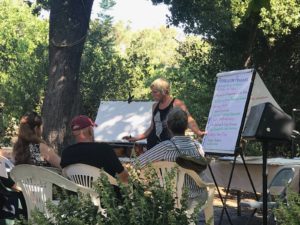 When it comes to the changing the environment and global climate change, the cause of the problem — humans — can also be the key to the solution.
When it comes to the changing the environment and global climate change, the cause of the problem — humans — can also be the key to the solution.
That was the hopeful message permaculture expert Lydia Neilsen brought to a crowd of listeners on a warm August Saturday morning at Morningsun Herb Farm in Vacaville. The event shared Neilsen’s insights on how permaculture can help restore the local water cycle and was also the official launch of Sustainable Solano’s expansion of its Sustainable Backyard program into Vacaville.
Neilsen began with an overview of the ethics and principles behind permaculture for a crowd where about one-third were new to the concept. Everything stems from the ethics of:
• Earth care (repair, conserve and regenerate)
• People care (seek peace and guard human rights everywhere)
• Fair share (giving back what you have extra of, whether time, money, produce, etc.)
“Our actions have become decoupled from their consequences,” she said. Permaculture involves getting back to that system of relationships.
She then turned to the intricacies of the water cycle and how that has been disrupted — and what can be done on an individual and community level to restore it locally.
“We have been treating rainwater as a nuisance,” she said, referring to how cities pave, pipe and drain water away.
That approach and the removal of plants create dry, dead soil and intensify heat. Rising heat can push water vapor away and create areas that are hotter and drier than if trees and vegetation were present to capture the sun’s rays and not only shade but also to photosynthesize and release oxygen and moisture back into the air. On the scale of a forest, trees work to harvest water vapor, creating low-pressure zones and pulling in more moisture, moving it inland. Take away the forests, and that cycle is disrupted.
“We’ve been impacting it for a long time negatively, and now we can impact it positively,” she said.
The permaculture approach of slowing, spreading and sinking water is a different approach from how rainwater has been treated, keeping water where it does the most good. The other factor in the equation is the need for vegetation.
So much that the world faces is on the global scale, but there is hope to be found in what can be addressed on the human scale.
“What can I do with my shovel to make an impact?” she said. An individual can do a lot through thoughtful observation to determine what needs to be done to help the land — and such efforts can spread. As one crowd member said, “It’s so easy. I mean, I know it’s not easy, but it’s so logical.”
A fruit tree guild — a central fruit tree surrounded by supporting plants that supply mulch, fix nitrogen, attract insects, suppress grass growth and help accumulate nutrients — is “a great place to start,” Neilsen said. Add a greywater system that reuses household water in the garden and it’s a step toward healing that local water cycle by nurturing water and plants on the property. “Imagine if whole neighborhoods were putting in food forests like this,” she said.
Sustainable Landscaping Program Manager Nicole Newell noted that approach is being used in Sustainable Solano’s backyard demonstration food forests. The program, which is taking applications through Sept. 21, will select two private yards and one public space in Vacaville for the demonstration gardens, which volunteers will create through a series of workshops to capture rainwater, install a greywater system and create water-wise, sustainable gardens.
Resources:
During her talk, Neilsen mentioned several books she turns to as resources on the topics she discussed. They include:
Water for the recovery of the climate — a new water paradigm (a research paper)
Hidden Nature: The startling insights of Viktor Schauberger (by Alick Bartholomew)
Permaculture: A Designer’s Manual by Bill Mollison
Rainwater Harvesting For Drylands And Beyond by Brad Lancaster

